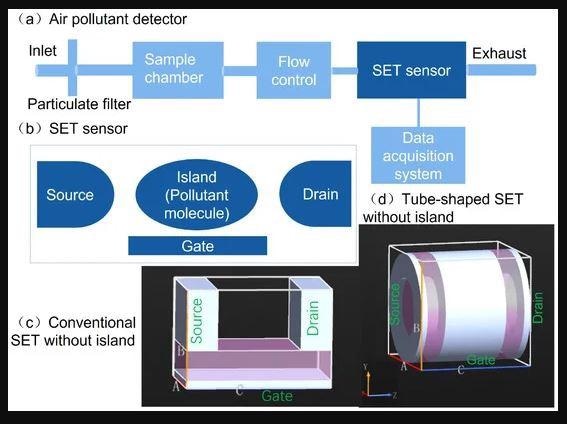Whenever toxic or insufficient amounts of chemicals are put into the Earth's atmosphere, it causes environmental and public health issues. A research paper published in Molecules Journal investigates using an air pollution monitor built on a tube-shaped single-electron transistor (SET) sensor.
Every air pollutant particle may be positioned in the center of a SET nanoparticle and handled as an island of the SET technology in the same structure by measuring the flow control element of the detectors.

Study: Detecting Air Pollutant Molecules Using Tube-Shaped Single Electron Transistor. Image Credit: nEwyyy/Shutterstock.com
Across the healthcare sector, the damaging consequences of air pollution have already been detected in multiple organs, resulting in numerous clinical illnesses, including malignancy. There are harmful impacts of air pollution on personal well-being, with physical consequences of exposure to air pollution acknowledged. Within the environmental sector, air pollution may harm ecosystem functioning and systems, as well as cause global warming, smog, and ozone layer depletion.
Technology to Quantify Air Pollutants
Various methods have already been developed to identify and quantify air contaminants in the atmosphere and determine pollution levels. A large range of methods and devices have been discovered for sampling and determining the concentration levels of various components of air pollution. Chromatography, fluorometry, infrared spectroscopy, spectrophotometry, and atomic emission spectroscopy are examples of these techniques. There are both direct and indirect measures employed.
The sizes and concentrations of particles trapped on filters, the percentages of gases gathered in traps, the pH levels of the water phase, the temperatures, and the humidity are all direct measurements. Other measures are based on assumption or indirectly, such as light scattering techniques used to estimate the quantity of aerosol particulates in the atmosphere.

Schematic of an air pollutant detector based on a single-electron transistor (SET) sensor. Image Credit: Huang, Z., et al.
Newest Method by SET Detectors
The application of semiconductor materials to monitor air quality seems attractive, considering the enormous usage of semiconductors in gas sensors. Single-electron transistors (SETs) built on sequential transmission can overcome the existing challenges caused by coherent transport.
A tube-shaped SET sensor, which was the central element of the sensor, was used to develop an air pollution monitoring system in this study. An air pollutant particle might travel to the center of the SET nanoparticle and behave as a SET island if the flow measurement component detects it. Using the theoretical method, the electronic characteristics of island particles in the SET environment were explored.
A contaminants filter cleans particulates from evaluated air, an air sample chamber samples ambient air, and a subsystem moves the selected sample into a SET sensor. A data processing subsystem then analyzes the results.
In practice, the flow measurement component would direct molecules into narrow tubes that only allow individual molecules to pass through. The molecules would then be accurately drawn through the pore in the SET sensor by a vertical electric field.
The time it took to detect a molecule also included the time it took to bring the molecule into the sensor's needed locations, the time it took to complete an individual test, and the time it took to analyze the data collected. The molecule is handled as a static island of the SET technology during the measuring procedure.
The Impact of SET Technology
The tube-shaped SET detector might be used in a variety of ways; for instance, because of its high sensitivity, adaptability, and raised temperature range, this SET-based sensor is a good choice for monitoring air quality at the microscopic level. The device's applicability for detecting additional harmful compounds and building more flexible sensor setups for continuous sensing of pollutant molecules are also being researched.
The introduction of small-scale pollutant sensors has resulted in a substantial fundamental shift in focus to air quality measurement beyond what is possible with traditional approaches that rely on big, immobile, and costly analyzers.
These detectors are often not compact, but they may also be portable, giving information near-real time with low costs and little power consumption. Consequently, sensors provide unparalleled temporal and regional accuracy in air quality measurements, altering our understanding of our environment.
Researchers are using sensor-based monitoring systems better to evaluate pollution levels and its health and environmental effects.
Next Advancement of SET Technology
The novel technology was utilized to identify air pollution compounds that are regularly seen. As each molecule's computed charge stability diagrams were unique, they may be utilized as a fingerprint for detection. Future developments may involve altering the scale to more significant levels so the pollution in a city can be detected using this method.
Continue reading: Nanostructured Thin Films in Gas Sensor Devices: An Overview.
Reference
Huang, Z., et al. (2021) Detecting Air Pollutant Molecules Using Tube-Shaped Single Electron Transistor. Molecules, 26(23), 7098; https://www.mdpi.com/1420-3049/26/23/7098/htm
Disclaimer: The views expressed here are those of the author expressed in their private capacity and do not necessarily represent the views of AZoM.com Limited T/A AZoNetwork the owner and operator of this website. This disclaimer forms part of the Terms and conditions of use of this website.